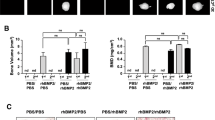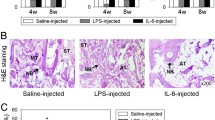Abstract
The osteoinductive activity induced by recombinant human BMP-2 (rhBMP-2) blunts proportionately as the recipient ages. In order to compensate for this bluntness administration of fibroblast growth factor-2 (FGF-2) has been considered. The aim of this study was to determine whether FGF-2 administration augments osteoinductive activity caused by rhBMP-2 and to evaluate the effect of aging on bone formation induced by coadministration of rhBMP-2 and FGF-2. Sixty-four Wistar strain male rats of 8-week-old (prepubertal) and 16-week-old (postpubertal) received bone defects bilaterally in the parietal bone and the defects were filled by a polylactic acid polyglycolic acid copolymer/gelatin sponge (PGS) impregnated with rhBMP-2 plus 0 ng, 25 ng, and 250 ng FGF-2 (n=10 in each). At 2 weeks after grafting, the new bone volume seemed to be larger in the rhBMP-2+FGF-2 groups than in the rhBMP-2 alone group. At 4 weeks, the new bone formation was linked to the adjacent original bone. In the prepubertal rats, all newly formed bone was similarly calcified. In the postpubertal rats, only the rhBMP-2+25 ng FGF-2 group showed this higher degree of calcification. At 2 weeks, alkaline phosphatase (ALP) activity in the rhBMP-2+25 ng FGF-2 group was significantly (p<0.05) larger than that in the rhBMP-2 group in both prepubertal and postpubertal rats. This result shows that low-dose administration of FGF-2 enhanced the degree of calcification and ALP activity in the rhBMP-2 grafting site especially in the postpubertal rats. Therefore, FGF-2 would be a candidate to compensate for the reduction of osteoinductive activity of rhBMP-2 with aging.






Similar content being viewed by others
REFERENCES
Akita, S., M. Fukui, H. Nakagawa, T. Fujii, and K. Akino. Cranil bone defect healing is accelerated by mesenchymal stem cells induced by coadministration of bone morphogenetic protein-2 and basic fibroblast growth factor. Wound Repair Regen. 12:252–259, 2004.
Almer, M. H. Age factor in human alveolar bone repair. J. Oral Implantol. 19:138–142, 1993.
Becerra, J., J. A. Andrades, D. C. Ertl, N. Sorgente, and M. E. Nimni. Demineralized bone matrix mediates differentiation of bone marrow stromal cells in vitro: Effect of age of cell donor. J. Bone Miner. Res. 11:1703–1714, 1996.
Bessho, K., and T. Iizuka. Changes in bone inducing activity of bone morphogenetic protein with aging. Ann. Chir. Gynaecol. 207:S49–S53, 1993.
Biovin, G., and C. A. Baud. Microradiographic methods for calcified tissues. In: Methods of Calcified Tissue Preparation, edited by G. R. Dickson. Amsterdam: Elsevier Science, 1984, pp. 391–412.
Carmeliet, P., and R. K. Jain. Angiogenesis in cancer and other diseases. Nature 407:249–257, 2000.
Connolly, D. T., B. L. Stoddard, N. K. Harakas, and J. Feder. Human fibroblast-derived growth factor is a mitogen and chemoattractant for endothelial cells. Biochem. Biophys. Res. Commun. 144:705–712, 1987.
Fleet, J. C., K. Cashman, K. Cox, and V. Rosen. The effects of aging on the bone inductive activity of recombinant human bone morphogenetic protein-2. Endocrinology 137:4605–4610, 1996.
Fujimura, K., K. Bessho, Y. Okubo, K. Kusumoto, N. Segami, and T. Iizuka. The effect of fibroblast growth factor-2 on the osteoinductive activity of recombinant human bone morphogenetic protein-2 in rat muscle. Arch. Oral Biol. 47:577–584, 2002.
Globus, R. K., P. Patterson-Buckendahl, and D. Gospodarowicz. Regulation of bovine bone cell proliferation by fibroblast growth factor and transforming growth factor β. Endocrinology 123:98–105, 1988.
Gospodarowicz, D., N. Ferrara, L. Schweigerer, and G. Neufeld. Structural characterization and biological functions of fibroblast growth factor. Endocrinol. Rev. 8:95–114, 1987.
Higuchi, T., A. Kinoshita, K. Takahashi, S. Oda, and I. Ishikawa. Bone regeneration by recombinant human bone morphogenetic protein-2 in rat mandibular defects. An experimental model of defect filling. J. Periodontol. 70:1026–1031, 1999.
Jergesen, H. E., J. Chua, R. T. Kao, and L. B. Kalsau. Age effects on bone induction by demineralized bone powder. Clin. Orthop. Relat. Res. 268:253–259, 1991.
Katagiri, T., A. Yamaguchi, T. Ikeda, S. Yoshiki, J. M. Wozney, V. Rosen, E. A. Wang, H. Tanaka, S. Omura, and T. Suda. The non-osteogenic mouse pluripotent cell line, C3H10T1/2, is induced to differentiate into osteoblastic cells by recombinant human bone morphgenetic protein-2. Biochem. Biophys. Res. Commum. 15(172):295–299, 1990.
Kato, Y., and M. Iwamoto. Fibroblast growth factor is inhibitor of chondrocyte terminal differentiation. J. Biol. Chem. 265:5903–5909, 1990.
Kenley, R., L. Marden, T. Turek, L. Jin, E. Roz, and J. O. Holloinger. Osseous regeneration in the rat calvarium using novel delivery systems for recombinant human bone morphogenetic protein-2 (rhBMP-2). J. Biomed. Mater. Res. 28:1139–1147, 1994.
Kimoto, T., R. Hosokawa, T. Kubo, M. Maeda, A. Sano, and Y. Akagawa. Continuous administration of basic fibroblast growth factor (FGF-2) accelerates bone induction on rat calvaria—an application of a new drug delivery system. J. Dent. Res. 77:1965–1969, 1998.
Marden, L. J., J. O. Hollinger, A. Chaudhari, T. Turek, R. G. Schaub, and E. Ron. Recombinant human bone morphogenetic protein-2 is superior to demineralized bone matrix in repairing craniotomy defects in rats. J. Biomed. Mater. Res. 28:1127–1138, 1994.
Mayer, M., J. Hollinger, E. Ron, and J. Wozney. Maxillary alveolar cleft repair in dogs using recombinant human bone morphogenetic protein-2 and polymer carrier. Plast. Reconstr. Surg. 98:247–259, 1996.
Moerman, E. J., K. Teng, D. A. Lipschitz, and B. Lecka-Czernik. Aging activates adipogenic and suppresses osteogenic programs in mesenchymal marrow stroma/stem cells: The role of PPAR-gamma2 transcription factor and TGF-beta/BMP signaling pathways. Aging Cell 3:379–389, 2004.
Murakami, S., S. Takayama, M. Kitamura, Y. Shimabukuro, K. Tanagi, K. Ikezawa, T. Saho, T. Nozaki, and H. Okada. Recombinant human basic fibroblast growth factor (bFGF) stimulates periodontal regeneration in class II furcation defects created in beagle dogs. J. Periodontal. Res. 38:97–103, 2003.
Nagai, N., C. L. Qin, H. Nagatsuka, M. Inoue, and Y. Ishiwari. Age effects on ectopic bone formation induced by purified bone morphogenetic protein. Int. J. Oral Maxillofac. Surg. 28:143–150, 1998.
Nemzek, J. A., S. P. Arnoczky, and C. L. Swenson. Retroviral transmission by the transplantation of connective-tissue allografts. An experimental study. J. Bone Joint Surg. Am. 76:1036–1041, 1994.
Ohno, S., T. Doi, K. Fujimoto, C. Ijuin, N. Tanaka, K. Tanimoto, K. Honda, M. Nakahara, Y. Kato, and K. Tanne. RGD-CAP (betaig-h3) exerts a negative regulatory function on mineralization in the human periodontal ligament. J. Dent. Res. 81:822–825, 2002.
Presta, M., P. Dell'Era, S. Mitola, E. Moroni, R. Ronca, and M. Rusnati. Fibroblast growth factor/fibroblast growth factor receptor system in angiogenesis. Cytokine Growth Factor Rev. 16:159–178, 2005.
Reddi, A. H. Cell biology and biochemistry of endochondral bone development. Coll. Res. 81:822–825, 1981.
Rice, D. P., T. Aberg, Y. Chan, Z. Tang, P. J. Kettunen, L. Pakarinen, R. E. Maxson, and I. Thesloff. Integration of FGF and TWIST in calvarial bone and suture development. Development 127:1845–1855, 2000.
Shih, M. S., M. A. Cook, C. A. Spence, S. Palnitkar, H. McElroy, and A. M. Parfitt. Relationship between bone formation rate and osteoblast surface on different subdivisions of the endosteal envelope in aging & osteoporosis. Bone 14:519–521, 1993.
Sontag, W. Age-dependent morphometric alterations in the distal femora of male and female rats. Bone 13:297–310, 1992.
Tan, H., A. Ransick, H. Wu, S. Dobias, Y. H. Liu, and R. Maxson. Disruption of primary mesenchyme cell patterning by misregulated ectodermal expression of SpMsx in sea urchin embryos. Dev. Biol. 201:230–246, 1998.
Toriumi, D. M., H. S. Kotler, D. P. Luxeberg, M. E. Holtrop, and E. A. Wang. Mandibular reconstruction with a recombinant bone inducing factor. Functional, histologic, and biomechanical evaluation. Arch. Otolaryngol. Head Neck Surg. 117:1101–1112, 1991.
Urist, M. R. Bone formation by autoinduction. Science 150:893–899, 1965.
Wada, K., A. Niimi, K. Watanabe, T. Sawai, and M. Ueda. Maxillary sinus floor augmentation in rabbits: A comparative histologic–histomorphometric study between rhBMP-2 and autogenous bone. Int. J. Periodont. Restorative Dent. 21:253–263, 2001.
Wang, E. A., V. Rosen, J. S. D'Alessandro, M. Bauduy, P. Cordes, T. Harada, D. I. Israel, R. M. Hewick, K. M. Kerns, P. Lapan, D. P. Luxenberg, D. Mcquaid, I. K. Moutsatsos, J. Nove, and J. M. Wozney. Recombinant human bone morphogenetic protein induces bone formation. Proc. Natl. Acad. Sci. U.S.A. 87:2220–2224, 1990.
Wang, J.-S., and P. Aspenberg. Basic fibroblast growth factor and bone induction in rats. Acta Orthop. Scand. 64:557–561, 1993.
Wozney, J. M. The potential role of bone morphogenetic proteins in periodontal reconstruction. J. Periodontol. 66:506–510, 1995.
Yamada, K., Y. Tabata, K. Yamamoto, S. Miyamoto, I. Nagata, H. Kikuchi, and Y. Ikada. Potential efficacy of basic fibroblast growth factor incorporated in biodegradable hydrogels for skull bone regeneration. J. Neurosurg. 86:871–875, 1997.
Yamaguchi, A. Regulation of differentiation pathway of skeletal mesenchymal cells in cell lines by transforming growth factor-beta superfamily. Semin. Cell Biol. 6:165–173, 1995.
Yamaji, K., A. Matsumoto, and H. Kato. Aging effect on bone formation induced by recombinant human BMP-2 combined with polylactat-polyactate-copolymaer/gelatine sponge complexes at palatal subperiosteal sites in rats. J. Jpn. Soc. Periodontol. 41:380–391, 1999.
Yokota, S., T. Uchida, S. Kokubo, K. Aoyama, S. Fukushima, K. Nozaki, T. Takahashi, R. Fujimoto, R. Sonohara, M. Yoshida, S. Higuchi, S. Yokohama, and T. Sonobe. Release of recombinant human bone morphogenetic protein 2 from a newly developed carrier. Int. J. Pharm. 30:57–66, 2003.
Yokota, S., S. Sonohara, M. Yoshida, M. Murai, S. Shimokawa, R. Fujimoto, S. Fukushima, S. Kokubo, K. Nozaki, K. Takahashi, T. Uchida, S. Yokohama, and T. Sonobe. A new recombinant human bone morphogenetic protein-2 carrier for bone regeneration. Int. J. Pharm. 223:69–79, 2001.
Zellin, G., and A. Linde. Effects of recombinant human fibroblast growth factor-2 on osteogenic cell populations during orthopic osteogenesis in vivo. Bone 26:161–168, 2000.
Author information
Authors and Affiliations
Corresponding author
Rights and permissions
About this article
Cite this article
Tanaka, E., Ishino, Y., Sasaki, A. et al. Fibroblast Growth Factor-2 Augments Recombinant Human Bone Morphogenetic Protein-2-Induced Osteoinductive Activity. Ann Biomed Eng 34, 717–725 (2006). https://doi.org/10.1007/s10439-006-9092-x
Received:
Accepted:
Published:
Issue Date:
DOI: https://doi.org/10.1007/s10439-006-9092-x




